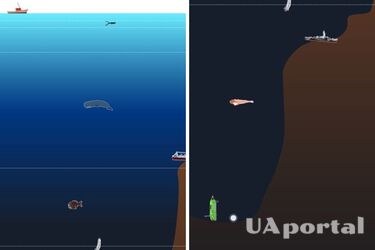Researchers show what the ocean depths really hide (photo)

The world's oceans cover about 70% of the Earth's surface, but people know less about them than they do about Mars. Scientists have not yet explored even a quarter of the ocean floor, and we know even less about what is hidden in its darkest and deepest corners.
According to the National Oceanic and Atmospheric Administration, only 5% of the world's oceans have been explored. This means that 95% of its territory is still a mystery. This was reported by the Daily Mail.
The ocean is conditionally divided into several zones depending on the depth:
- Epipelagic is the surface zone that receives light from the sun.
- Mesopelagic is a zone where light still penetrates, but is very weak.
- Batipelagia is a zone where darkness reigns.
- Abyssopelagic zone is the zone below 6000 meters.
- Hadalpelagia is the zone below 11,000 meters.
Extreme conditions prevail in the deep ocean: low temperatures, complete darkness, and extreme pressure. Only the most adapted organisms can survive in such conditions.
Also read: Asteroids have nothing to do with it: a new theory of the origin of life on Earth has emerged
Despite this, scientists have discovered many amazing creatures in the deep ocean waters. For example, a huge diverse world of deep-sea animals was discovered near the Izu-Ogasawara Trench south of Japan.
Sperm whales are also capable of diving to depths of over 2000 meters in search of prey. They prey on deep-sea squids, which also have an extraordinary ability to adapt to extreme conditions.
The deepest-sea creature ever discovered by humans is a snail found at a depth of 8300 meters.
Scientists continue to study the oceans, but they still hold many secrets for us.
As a reminder, humanity has been misinterpreting the main law of physics for 300 years.
If you want to get the latest news about the war and events in Ukraine, subscribe to our Telegram channel!
